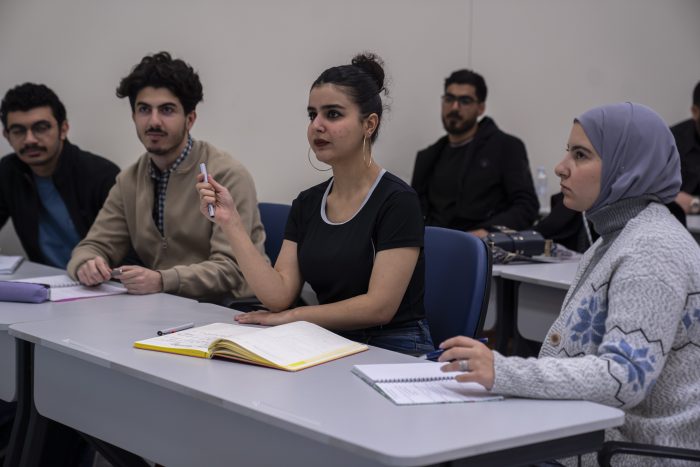Thomas Hayes Bringing Journalism and a Radio Station to Life at AUK
Thomas Hayes, Chair of the Department of General Education at the American University of Kurdistan (AUK), is instructing in the use of journalistic principles and media technology to broadcast one’s views. He plans to have a radio station and video production lab operational at AUK for the fall of 2023, and he is already training the students enrolled in his “Introduction to Journalism” course to run the venture. The equipment for the lab will be funded through a United States Department of State Grant titled “Support to American-Style Higher Education in Iraq.”
Mr. Hayes opened the door of his classroom to observers on January 25 to show the early stages of the student mentorship. As is commonplace for university classes, students were supposed to read a scholarly article and come prepared to discuss it. Students and Mr. Hayes, referencing their pre-class reading, talked of the defining features of radio: portability, intimacy, nimbleness (in that, with fairly little equipment or delay, an event can be covered), and storytelling. Mr. Hayes pointed out that “radio” is any sound medium, meaning podcasts count. Mr. Hayes and the students went back and forth on the adaptability of radio; its “golden age” was close to a century ago, but so many of today’s students listen to it in their cars and on their smartphones. Mr. Hayes, having worked for newspapers for years, had insights on the differences between print and spoken journalism to supplement those already given in the reading. Students had much to say on how radio and newspapers differ in giving emphasis to stories. To compete with print media and other information outlets, radio journalism uses short, punchy sentences, featuring the active voice and colloquialisms, so that the presentation of the news is more easily consumed by the audience.
Later in the class, attention shifted to a video on the interview process, since AUK’s radio station will have produce interviews of its own. Mr. Hayes stopped the video at strategic points and elicited comments from students, until the full list of interview pointers had been revealed: researching the interview subject; choosing a suitable location; preparing open-ended questions beforehand; letting the interviewee talk uninterruptedly; and proper transcription. As was apparent from his written plan on the board, Mr. Hayes originally intended to give students practice interviewing one another and “sharing out,” but the earlier discussions were so lively and in-depth that the practice had to be postponed for the next class.
The command of the material among the students indicated they were on pace to be radio journalists for the upcoming fall, and the enthusiasm of some was well ahead of the curve. Mr. Hayes stated that students should look to National Public Radio as a model for the kinds of programming he envisions for AUK’s platform; some may wish to look to his class as a model for journalism instruction.


